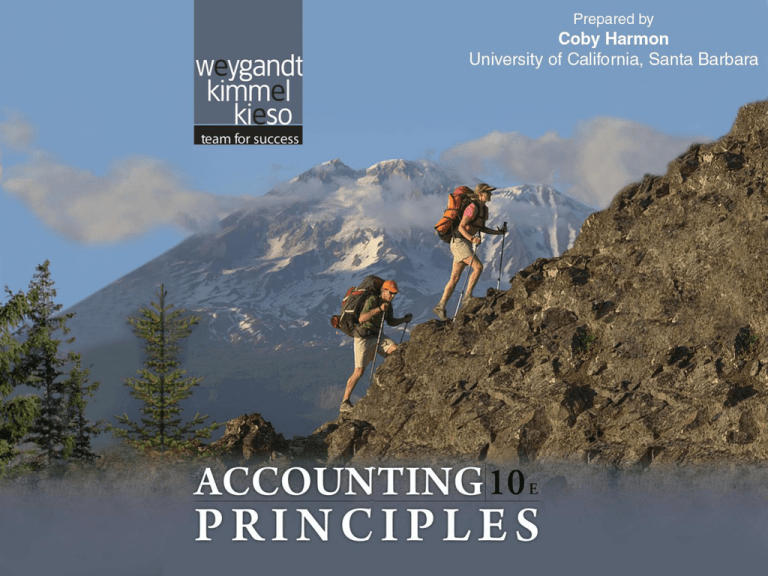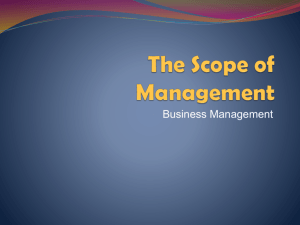
19-1
CHAPTER19
Managerial
Accounting
19-2
PreviewofCHAPTER19
19-3
Managerial Accounting Basics
Managerial accounting, a field of accounting that provides
economic and financial information for managers and other
internal users. Activities include:
1. Explaining manufacturing and nonmanufacturing costs
(Chapter 19).
2. Computing cost of providing a service or manufacturing a
product (Chapters 20 and 21).
3. Determining the behavior of costs and expenses as activity
levels change and analyzing cost–volume–profit relationships
within a company (Chapter 22).
19-4
Managerial Accounting Basics
Managerial accounting, a field of accounting that provides
economic and financial information for managers and other
internal users. Activities include:
4. Assisting management in profit planning and formalizing
these plans in the form of budgets (Chapter 23).
5. Providing a basis for controlling costs and expenses by
comparing actual results with planned objectives and
standard costs (Chapters 24 and 25).
6. Accumulating and presenting data for management decision
making (Chapter 26).
19-5
Managerial Accounting Basics
Comparing Managerial and Financial
Accounting
Illustration 19-1
19-6
SO 1 Explain the distinguishing features of managerial accounting.
Managerial Accounting Basics
Question
Managerial accounting:
a. Pertains to the entity as a whole and is highly
aggregated.
b. Places emphasis on special-purpose information.
c. Is limited to cost data.
d. Is governed by generally accepted accounting
principles.
19-7
SO 1 Explain the distinguishing features of managerial accounting.
Managerial Accounting Basics
Management Functions
Three broad functions:
1. Planning.
2. Directing.
Requires managers to look ahead and to
establish objectives.
market share,
3. Controlling.
19-8
maximizing short-term profits and
maintaining a commitment to
environmental protection, and
contributing to social programs.
SO 2 Identify the three broad functions of management.
Managerial Accounting Basics
Management Functions
Three broad functions:
1. Planning.
2. Directing.
3. Controlling.
19-9
Involves coordinating diverse activities and
human resources to produce a smoothrunning operation. This function relates to
implementing planned objectives,
providing necessary incentives to
motivate employees,
selecting executives,
appointing managers and
supervisors, and
hiring and training employees.
SO 2 Identify the three broad functions of management.
Managerial Accounting Basics
Management Functions
Three broad functions:
1. Planning.
2. Directing.
3. Controlling.
Process of keeping the company’s
activities on track.
Managers determine whether
planned goals are being met.
When there are deviations from
targeted objectives, managers must
decide what changes are needed to
get back on track.
19-10
SO 2 Identify the three broad functions of management.
Managerial Accounting Basics
Question
The management of an organization performs several
broad functions. They are:
a. Planning, directing, and selling.
b. Directing, manufacturing, and controlling.
c. Planning, manufacturing, and controlling.
d. Planning, directing, and controlling.
19-11
SO 2 Identify the three broad functions of management.
19-12
SO 2
Managerial Accounting Basics
Organizational
Structure
Illustration 19-2
19-13
SO 2
Managerial Accounting Basics
Business Ethics
Business scandals caused massive investment losses
and employee layoffs.
19-14
Corporate fraud has increased 13% in last 5 years.
Employee fraud – 60% of all fraud.
Intentional misstatement of financial reports.
►
Enron, Global; Crossing, WorldCom.
►
Most costly to companies.
SO 2 Identify the three broad functions of management.
Managerial Accounting Basics
Business Ethics
Creating Proper Incentives
Systems to monitor and evaluate employees may
produce incentives for unethical actions.
Employees may feel that they must succeed no
matter what.
Ineffective and unrealistic controls may result in
declining product quality.
19-15
SO 2 Identify the three broad functions of management.
Managerial Accounting Basics
Business Ethics
Code of Ethical Standards
19-16
Sarbanes-Oxley Act of 2002
►
Clarifies management’s responsibilities.
►
Certifications by CEO and CFO.
►
Selection criteria for Board of Directors and Audit
Committee.
►
Substantially increased penalties for misconduct.
IMA Statement of Ethical Professional Practices
SO 2 Identify the three broad functions of management.
Managerial Cost Concepts
Manufacturing Costs
Activities and processes that convert raw materials into
finished goods.
Illustration 19-3
19-17
SO 3 Define the three classes of manufacturing costs.
Manufacturing Costs
Direct Materials
Raw materials purchased that will be converted into finished
product.
Direct materials can be physically and directly
associated with the finished product.
Indirect materials:
1. Do not become part of the finished product, or
2. Cannot be traced directly to the product.
3. Part of manufacturing overhead.
19-18
SO 3 Define the three classes of manufacturing costs.
Manufacturing Costs
Direct Labor
Direct Labor - Work of factory employees that
can be physically and directly associated with converting
raw materials into finished goods.
Indirect Labor - Work of factory employees that
19-19
has no physical association with the finished product or
for which it is impractical to trace to the goods produced.
SO 3 Define the three classes of manufacturing costs.
Manufacturing Costs
Manufacturing Overhead
Costs that are indirectly associated with manufacturing
the product.
Includes all manufacturing costs except direct materials
and direct labor.
19-20
SO 3 Define the three classes of manufacturing costs.
19-21
Manufacturing Costs
Question
Which of the following is not an element of manufacturing
overhead?
a. Sales manager’s salary.
b. Plant manager’s salary.
c. Factory repairman’s wages.
d. Product inspector’s salary.
19-22
SO 3 Define the three classes of manufacturing costs.
Manufacturing Costs
Product versus Period Costs
Product Costs
Components: direct material cost, direct labor cost,
and manufacturing overhead.
Necessary and integral part of producing the product.
Recorded as inventory when incurred.
Not an expense until the finished goods inventory is
sold, then record as cost of goods sold.
19-23
SO 4 Distinguish between product and period costs.
Manufacturing Costs
Product versus Period Costs
Period Costs
Matched with revenue of a specific time period and
charged to expense as incurred.
Non-manufacturing costs.
Deducted from revenues in period incurred to determine
net income.
19-24
Includes all selling and administrative expenses.
SO 4 Distinguish between product and period costs.
Product versus Period Costs
Illustration 19-4
19-25
SO 4 Distinguish between product and period costs.
Manufacturing Costs
Income Statement
19-26
Illustration 19-5
SO 5 Explain the difference between a merchandising
and a manufacturing income statement.
Manufacturing Costs
Income Statement
19-27
Illustration 19-6
Cost of goods sold sections of
merchandising and manufacturing
income statements
SO 5 Explain the difference between a merchandising
and a manufacturing income statement.
Manufacturing Costs
Cost of Goods Manufactured
Illustration 19-7
Work in Process – partially completed units of product.
Total Manufacturing Costs – sum of direct material costs, direct
labor costs, and manufacturing overhead; all incurred in the current
period.
19-28
SO 6 Indicate how cost of goods manufactured is determined.
Manufacturing Costs
Illustration 19-8
Cost of goods
manufactured
schedule
19-29
SO 6
Manufacturing Costs
Balance Sheet
19-30
Illustration 19-9
Inventory accounts for
a manufacturer
SO 7 Explain the difference between a merchandising
and a manufacturing balance sheet.
Manufacturing Costs
Balance Sheet
19-31
Illustration 19-10
Current assets sections of
merchandising and
manufacturing balance sheets
SO 7 Explain the difference between a merchandising
and a manufacturing balance sheet.
Manufacturing Costs
Product Costing for Service Industries
19-32
U.S. economy has shifted toward an emphasis on
providing services rather than goods.
Over 50% of U.S. workers are now employed by service
companies.
Trend is expected to continue in the future.
Most of the techniques learned for manufacturing firms
are applicable to service companies.
SO 7 Explain the difference between a merchandising
and a manufacturing balance sheet.
19-33
Managerial Accounting Today
The Value Chain
All activities associated with providing a product or service.
Illustration 19-13
A manufacturer’s value chain
19-34
SO 8 Identify trends in management accounting.
Managerial Accounting Today
Technological Change
Enterprise Resource Planning (ERP) systems provide a
comprehensive, centralized, integrated source of information that
companies can use to manage all major business processes, from
purchasing to manufacturing to human resources.
Computer-Integrated Manufacturing (CIM) allows companies to
manufacture products that are untouched by human hands.
Business-to-Business (B2B) e-commerce on the Internet.
19-35
SO 8 Identify trends in management accounting.
Managerial Accounting Today
Just-In-Time Inventory Methods
Goods are manufactured or purchased just in time for
use.
Quality
19-36
JIT inventory system requires increased emphasis on
product quality.
Companies have installed total quality management
(TQM) systems to reduce defects in finished products.
SO 8 Identify trends in management accounting.
Managerial Accounting Today
Activity-Based Costing
Allocates overhead based on use of activities.
Results in more accurate product costing and scrutiny of
all activities in the value chain.
Theory of Constraints
19-37
A specific approach used to identify and manage
constraints in order to achieve the company’s goals.
SO 8 Identify trends in management accounting.
Managerial Accounting Today
Balanced Scorecard
19-38
Evaluates operations in an integrated fashion.
Uses both financial and non-financial measures.
Links performance measures to overall company
objectives.
SO 8 Identify trends in management accounting.
Managerial Accounting Today
Question
Which of the following managerial accounting techniques
attempts to allocate manufacturing overhead in a more
meaningful manner?
a. Just-in-time inventory.
b. Total-quality management.
c. Balanced scorecard.
d. Activity-based costing.
19-39
SO 8 Identify trends in management accounting.
Copyright
“Copyright © 2011 John Wiley & Sons, Inc. All rights reserved.
Reproduction or translation of this work beyond that permitted in
Section 117 of the 1976 United States Copyright Act without the
express written permission of the copyright owner is unlawful.
Request for further information should be addressed to the
Permissions Department, John Wiley & Sons, Inc. The purchaser
may make back-up copies for his/her own use only and not for
distribution or resale. The Publisher assumes no responsibility for
errors, omissions, or damages, caused by the use of these
programs or from the use of the information contained herein.”
19-40






